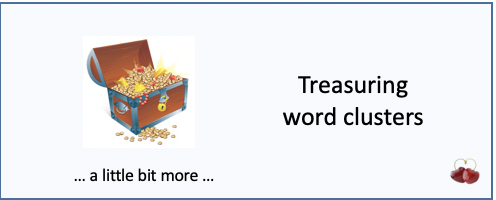55 – Treasuring word clusters
In my work I focus on word clusters as a key element of speech to focus on in the teaching of listening/decoding. The term ‘word cluster’ comes from Carter and McCarthy’s ‘Cambridge Grammar of English’ (2006), examples of word clusters include ‘a bit of a’ and ‘I was going to’. Other authors refer to them as recurrent chunks or formulaic chunks (Field, 2008: 155). Such clusters are an important component of all types of language, and I argue in ‘A Syllabus for Listening – Decoding’ that they are an essential component of the listening syllabus for all levels of learners, even advanced. It may seem surprising that I mention advanced learners but I do so because John Field’s research has shown that even advanced learners have difficulty with such clusters (Field, 2008: 146).
Another reason for focussing on them is that they occur across a wide variety of speech styles and topics. So learning the variety of possible sound shapes of these clusters provides high surrender value. But why do so, you may ask, surely we can ignore these bits and simply focus on the content words and thereby build meanings. No, no and three times no! Not if our learners want to learn the language, and not simply indulge in communicative coping.
Recordings as treasure troves of meaning
All recordings are treasure troves of sound shapes and soundscapes of the words and speech unit. All of the recording – not just the set of content words it contains – provides matter for teaching and learning. To go metaphorical for a moment – the gems of meaning are contained in, and surrounded by, layers of mineral substance – the sound substance of clusters of very common words. The way we currently focus on the meaning gems alone in our listening classes results in testing and coping activities, which don’t allow room to learn about, and learn how to handle, the mineral layers of sound substance in which the gems occur.
Clusters are fast
Part of the reason why word clusters are challenging for advanced learners is that they are often much faster than their immediate neighbours in the stream of speech.
Take for example one of the closing sentences of a TED talk by Julian Treasure, which goes
I’m going to leave you with with a little bit more birdsong
TED 660 JULIAN Treasure The 4 ways sound affects us 21 July 2009
Interestingly, the TED transcript gives fewer words than this: I’ll leave you with more birdsong – omitting words which don’t contribute hugely to meaning is quite common in such transcripts. The length of this talk is 5 minutes 26 seconds, with an average speed of 207.42 words per minute (as measured by the TED Corpus Search Engine here).
Speed of the sentence
I measure the duration of this sentence at 1.7 seconds. If we take a Garden approach to counting words (counting standard contractions – I’m and gonna – as single words, and I’m gonna as three syllables) then
- there are 10 words
- the speed is 5.9 words per second,
- which comes to 354 words per minute – 75% faster than the average speed
- there are 13 syllables
- the speed is 7.7 syllables per second
- which comes to 460 syllables per minute
So this whole sentence itself is already much faster than the talk as a whole. At this point I would like to compare the speed-in-syllables of this sentence with the speed-in-syllables of the recording as a whole, but I don’t have this available to me, but see below for more on speed as measured in syllables.
Speed of the cluster
Let’s turn our attention to the five-word cluster with a little bit more.
- I measure the duration at 0.663 seconds,
- there are 5 words
- the speed is 7.5 words per second
- which comes to 450 words per minute –
- there are six syllables
- the speed 9 syllables per second
- which comes to 540 syllables per minute
Thus this sentence goes at more than twice the average speed of the talk as a whole (207.42) and ca. 30% faster than the full sentence in which it occurs. Let’s now turn to a syllable count:
Just as I mentioned above, at this point I would like to compare the speed in syllables of this cluster with the speed-in-syllables of the recording as a whole, but I don’t have this available to me. However what we can do is compare it to the notions of ‘fastest’ speech in the research literature. A commonly accepted measure in the research literature of the ‘fastest’ speed for spontaneous speech is at 324 wpm or 5.4 sps (Field, 2019:63; Laver, 1994:541). This is way lower than both the sentence and the word cluster that we have looked at.
Does anyone know of any research into speed of speech that looks not just at minute-measured averages, but (as we have done above) what the extremes are that are hidden by average measures?



Leave a Reply